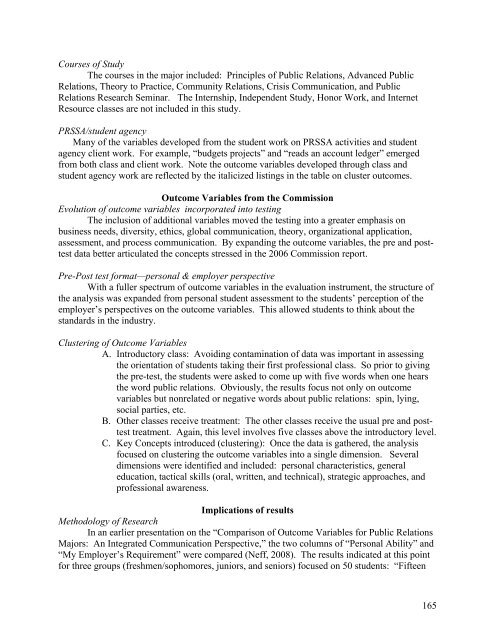2008 PROCEEDINGS - Public Relations Society of America
2008 PROCEEDINGS - Public Relations Society of America
2008 PROCEEDINGS - Public Relations Society of America
You also want an ePaper? Increase the reach of your titles
YUMPU automatically turns print PDFs into web optimized ePapers that Google loves.
Courses <strong>of</strong> Study<br />
The courses in the major included: Principles <strong>of</strong> <strong>Public</strong> <strong>Relations</strong>, Advanced <strong>Public</strong><br />
<strong>Relations</strong>, Theory to Practice, Community <strong>Relations</strong>, Crisis Communication, and <strong>Public</strong><br />
<strong>Relations</strong> Research Seminar. The Internship, Independent Study, Honor Work, and Internet<br />
Resource classes are not included in this study.<br />
PRSSA/student agency<br />
Many <strong>of</strong> the variables developed from the student work on PRSSA activities and student<br />
agency client work. For example, “budgets projects” and “reads an account ledger” emerged<br />
from both class and client work. Note the outcome variables developed through class and<br />
student agency work are reflected by the italicized listings in the table on cluster outcomes.<br />
Outcome Variables from the Commission<br />
Evolution <strong>of</strong> outcome variables incorporated into testing<br />
The inclusion <strong>of</strong> additional variables moved the testing into a greater emphasis on<br />
business needs, diversity, ethics, global communication, theory, organizational application,<br />
assessment, and process communication. By expanding the outcome variables, the pre and posttest<br />
data better articulated the concepts stressed in the 2006 Commission report.<br />
Pre-Post test format—personal & employer perspective<br />
With a fuller spectrum <strong>of</strong> outcome variables in the evaluation instrument, the structure <strong>of</strong><br />
the analysis was expanded from personal student assessment to the students’ perception <strong>of</strong> the<br />
employer’s perspectives on the outcome variables. This allowed students to think about the<br />
standards in the industry.<br />
Clustering <strong>of</strong> Outcome Variables<br />
A. Introductory class: Avoiding contamination <strong>of</strong> data was important in assessing<br />
the orientation <strong>of</strong> students taking their first pr<strong>of</strong>essional class. So prior to giving<br />
the pre-test, the students were asked to come up with five words when one hears<br />
the word public relations. Obviously, the results focus not only on outcome<br />
variables but nonrelated or negative words about public relations: spin, lying,<br />
social parties, etc.<br />
B. Other classes receive treatment: The other classes receive the usual pre and posttest<br />
treatment. Again, this level involves five classes above the introductory level.<br />
C. Key Concepts introduced (clustering): Once the data is gathered, the analysis<br />
focused on clustering the outcome variables into a single dimension. Several<br />
dimensions were identified and included: personal characteristics, general<br />
education, tactical skills (oral, written, and technical), strategic approaches, and<br />
pr<strong>of</strong>essional awareness.<br />
Implications <strong>of</strong> results<br />
Methodology <strong>of</strong> Research<br />
In an earlier presentation on the “Comparison <strong>of</strong> Outcome Variables for <strong>Public</strong> <strong>Relations</strong><br />
Majors: An Integrated Communication Perspective,” the two columns <strong>of</strong> “Personal Ability” and<br />
“My Employer’s Requirement” were compared (Neff, <strong>2008</strong>). The results indicated at this point<br />
for three groups (freshmen/sophomores, juniors, and seniors) focused on 50 students: “Fifteen<br />
165
















